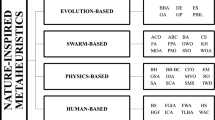Abstract
In the present era, which is characterized by an unprecedented deluge of data, coming from many diversified sources, classical optimization methods often are not able to reach the target of finding “the best solution” to a mathematical problem. In this context, methods that imitate natural phenomena, and in particular animal behavior, have proven to be more effective and to some extent, more easily applicable to a wide range of optimization problems. These methods essentially are based on the self-organization of swarms or populations of individuals, who keep some individual freedom, but have a tendency to “follow the best” in the group, which is a behavior very frequently observed in animal and even human societies. The interaction of biologists, ecologists, and social scientists with mathematicians, who have been able to capture the main traits of the evolutionary success of a species or society and to reuse, interpret, and embed them into an algorithm, has brought to the definition of a family of nature-inspired optimization methods, which since some years contribute in a fundamental way to the innovation of many productive and social processes.
Access this chapter
Tax calculation will be finalised at checkout
Purchases are for personal use only
Similar content being viewed by others
References
Bozorg-Haddad O (2018) Advanced optimization by nature-inspired algorithms, 1st edn. Springer Publishing Company, Incorporated
Colorni A, Dorigo M, Maniezzo V (1992) Distributed optimization by ant colonies, pp 134–142. MIT Press
Dorigo M (1992) Optimization, learning and natural algorithms. PhD thesis, Politecnico di Milano
Dorigo M, Stützle T (2004) Ant colony optimization. MIT Press
Du KL, Swamy MNS (2016) Search and optimization by metaheuristics: techniques and algorithms inspired by nature. Birkhäuser Basel, 1st edn
Holland JH (1992) Adaptation in natural and artificial systems. University of Michigan Press, Ann Arbor, MI, 1975. second edn
Micheletti A, Aletti G, Ferrandi G, Bertoni D, Cavicchioli D, Pretolani R (2020) A weighted \(\chi ^2\) test to detect the presence of a major change point in nonstationary markov chains. Stat Methods Appl
Micheletti A, Morale D, Rapati D, Nolli P (2010) A stochastic model for simulation and forecasting of emergencies in the area of Milano
Micheletti A, Nakagawa J, Alessi AA, Morale D, Villa E (2016) A germ-grain model applied to the morphological study of dual phase steel. J f Math Ind 6(1):12
Mirjalili S, Mirjalili SM, Lewis A (2014) Grey wolf optimizer. Adv Eng Softw 69:46–61
Muro C, Escobedo R, Spector L, Coppinger R (2011) Wolf-pack ( canis lupus ) hunting strategies emerge from simple rules in computational simulations. Behav Process 88(3):192–197
Rajabioun R (2011) Cuckoo optimization algorithm. Appl Soft Comput 11(8):5508–5518
Rancoita PMV, Giusti A, Micheletti A (2011) Intensity estimation of stationary fibre processes from digital images with a learned detector. Image Anal Stereol 30(3):167–178
Richardson P (2008) The secrete life of bats. Natural History Museum London
Spall JC (2003) Introduction to Stochastic search and optimization, 1st edn. John Wiley & Sons Inc, USA
Xing B, Gao WJ (2016) Innovative computational intelligence: a rough guide to 134 clever algorithms, 1st edn. Springer Publishing Company, Incorporated
Yang X (2010) A new metaheuristic bat-inspired algorithm, pp 65–74. Springer Berlin Heidelberg, Berlin, Heidelberg
Yang XS (2012) Flower pollination algorithm for global optimization, vol 7445 of Lecture Notes in Computer Science. Springer, Berlin, Heidelberg
Author information
Authors and Affiliations
Corresponding author
Editor information
Editors and Affiliations
Rights and permissions
Copyright information
© 2020 Springer Nature Switzerland AG
About this chapter
Cite this chapter
Micheletti, A. (2020). Nature-Inspired Optimization Methods: How Ants, Bees, Cuckoos, and Other Friends May Improve the Work of Mathematicians. In: La Porta, C., Zapperi, S., Pilotti, L. (eds) Understanding Innovation Through Exaptation. The Frontiers Collection. Springer, Cham. https://doi.org/10.1007/978-3-030-45784-6_2
Download citation
DOI: https://doi.org/10.1007/978-3-030-45784-6_2
Published:
Publisher Name: Springer, Cham
Print ISBN: 978-3-030-45783-9
Online ISBN: 978-3-030-45784-6
eBook Packages: Physics and AstronomyPhysics and Astronomy (R0)




